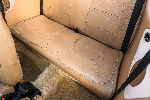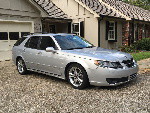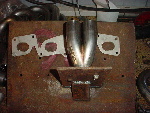
1994-2002 [Subscribe to Daily Digest] |
jd,
I was not involved in the design of the current generation 9-3 suspension.
OK I started writing a fairly decent response but found that there was just too much to cover to explain why your car rides the way it does without getting into some suspension fundamentals. Basically it comes down to a few things: High friction levels, flexible chassis, and poor wheel control strategy in the rear.
Roll issues are basically governed by the roll stiffness of the vehicle, and the distance from the center of gravity to the roll axis. A stiff chassis would also help here since roll stiffness in the front is not equal to that in the rear.
If you are looking for a cheap fix it is not really there. You can use taller (softer tires) or inflate the ones you have to a little lower pressure to help the ride issues, but that will reduce your cornering capabilities. I honestly don't advise that.
As far as roll goes you could go with aftermarket stiffer roll bars, but if you do this I would advise doing this to both the front and the rear. (If you only add roll stiffness to the front you will increase understeer.) The other issue with stiffer roll bars is that the chassis has to be stiff enough in torsion for them to make a difference. Stiffer springs would also increase your roll stiffness, but they would also increase your ride stiffness which seems to be an issue already.
Below is the original response that I was working on, but I do not know how much help it will be...I never got to explain how the fundamentals affect the 9-3, but it is a decent discussion of some basics. The stuff on roll is probably more interesting than the stuff on friction.
Suspension basics:
Ride events are usually taken to be those where the left and right wheels are moving into jounce and rebound together (in phase) Roll events are taken to be those where the left and right wheel are moving in opposite directions. (one into jounce, one into rebound) Ride stiffness is usually a function of the springs and tires only. Roll stiffness is a function of the springs tires, and anti-sway bars. There are also asymetric ride events such as a pothole that only one wheel encounters, which will bring the anti-sway bar into effect.
In Ride we are usually looking to isolate the wheel motions from the body. To do this generally two things are needed. First is a fairly soft (spring and damper) suspension, and secondly is low friction.
The soft suspension allows the wheel to move up and down relitively large amounts without large changes in the force at the tower (F=kx, where k is low larger values of x can be tolerated before forces get too large.) If the suspension is too soft it will not have sufficient travel to handle large potholes. If the suspension is too hard, small bumps will feel more harsh. All of this assumes no friction. Many times progressive springs are used that allow the first bit of travel to happen at relitively low spring rates which get progressively higher as the spring is compressed. This can be used to help smooth road ride yet still maintain sufficeintly stiff rates for rough roads.
Once friction is taken into account the story changes a little. Even extremely softly sprung suspensions will feel harsh if there are large amounts of friction present. When friction is taken into account (sometimes called "sticktion") the suspension will not be able to move until the friction forces are overcome. If the suspension cannot move, isolation will be left solely to the tire which is an extremely stiff spring relitive to the suspension spring and has very little damping.
When friction is preventing the suspension from moving we call it "riding the tire" Since the tire is such a stiff spring, small deflections caused by road cracks etc will cause large changes in force and they will be transmitted directly to the body. (and then your ass with only the seat to filter them out.)
Where does friction come from? Well looking at the 9-3 front suspension there are two main sources. The first and most significant comes from the bending loads in the strut. The second source is the friction in the lower control arm bushings. Since the strut is the main source lets talk about that.
This is a time when a picture is worth a thousand words... But since I don't really know how to post a picture, I guess I will type a thousand words... If you were to take a free body diagram of a simplified front strut corner you would see three main places where forces are acting. The simplified corner would be a rear view with a simple Lower Control Arm (LCA) that is oriented horizontally. (Basically you have a triangle of points, the center of the tire contact patch and ground, the upper strut mount, and the inner mount for the LCA. The force at the tire is taken as vertical and acting at the center of the tire contact patch. The lower control arm is mounted with a revolute joint on the inside and a ball joint on the outside so it can only support axial force.
The first force would be vertical and directed up located at the center of the tire contact patch. The next force would be horizontal and directed towards the center of the car located at the LCA inner mounting point, and the third force would be pointing down and out and located at the upper strut mount. For force and moment equilibrium to exist the force at the upper strut mount must pass through the intersection of the lower control arm and the center of the tire contact patch. A FBD would quickly show this.
Now the problem. To do this we would want the spring to be physically mounted in this orientation. Due to packaging constraints this is rarely achieveable. The packaging constraint is that the strut tube will run into the tire if it were located along this axis. So the strut is leaned inboard. Since the spring coils over the strut the spring is constained by this as well. To help out a little the spring is usually not concentric to the strut, but angled further out. (The spring is usually at an angle relative to the strut. the top of the spring is usually concentric with the top of the strut , but the bottom of the spring is often not concentric, but moved outboard above the top of the tire) Unfortunately the spring still can't act along the appropriate line of action. However from equilibrium we know that the force at the strut mount must pass through the intersection of the an extension of the LCA and the center of the tire contact patch. So a force perpendicular to the strut at the top of the strut arises to make the resultant force at the strut top mount act along the proper axis. (Perpendicular because the strut is basically a slider which can not suport any load along its axis) This "side load" causes a moment to act on the strut and a force to act perpendicular to the piston-cylinder. The perpendicular force than causes friction between the piston and cylinder. There are some novel methods of reducing the bending moment the strut encounters but the 9-3 does not implement many of them. So there is one source of poor ride.
Now we move to the rear suspension which is basically a torsion beam rear axle with coil springs. This is far from a sophisticated suspension system and has some issues. Since the structural axle also has to be flexible tuning parameters are not optimum oftentimes. The suspension also results in not so nice changes in track width with jounce and rebound (Since the wheel basically moves along an arc traced out by the virtual side view swing arm. One good thing about this design is that the shock is oriented fairly vertical which helps isolation.
Roll control is a different ballgame and is usually handled through anti-roll bars. Anti roll bars serve two purposes. The first is to reduce body roll and the second is to control under/oversteer. When a car goes through a turn it is subjected to a rolling moment equal to the mass of the car times its linear velocity squared divided by the radius of the turn times the distance between the center of gravity and the roll axis. If the CG is above teh roll axis (as it always is) the moment will cause the car to roll "out" of a turn. If the CG was below the roll axis, the car would roll "into" the turn.
The roll moment has to be reacted so more load is placed on the outside tires than the inside tires to balance teh roll moment. Regardless of what type of antiroll bar you have, or the amount that the vehicle rolls, the difference in force between the outer wheels and the inner wheels is the same. It will basically be the roll moment divided by the track width.
So what does adding a anti sway bar do? It can shift the distribution of the roll moment between the front and rear wheels. Lets look at an example. Lets say we have a perfectly symetric and balanced 4000 pound auto that has 1000 pounds acting on each tire statically. We go around a turn and have equal roll stiffness front and rear and now the outer tires support 1250 pounds each and the inners support 750 each. (Always adds up to weight of vehicle) Now we put an anti-sway bar of infinite stiffness in the front, so all of the roll moment is reacted there. The outside front tire will be loaded at 1500 pounds, the inside front at 500, and the two rear tires will be at 1000 each. If the infinite stiffness bar was on the rear, the situation would be outside rear at 1500, inside rear at 500, two front tires at 1000.
Now we need to look at cornering stiffness of a tire and the fact that it is nonlinear. As the load on a tire increases, the cornering stiffness increases, but at a decaying rate. (Curve has positive first derivative and negative second derivative.) The cornering stiffness of the front is equal to the sum of the inner and the outer. Making up some numbers lets say that at 500 pounds the cornering stiffness of the tire is one unit. At 1000 pounds the stiffness would be less than two units, lets say approximately 1.5 units, at fifteen hundred pounds lets say it is at 1.75 units. Lets make a quick hypothetical chart:
500 = 1 750 = 1.3 1000 = 1.5 1250 = 1.6 1500 = 1.65
So the total cornering stiffness of the front when we had equal roll stiffness was 1.3 + 1.6 = 2.9 When we had infinite roll stiffness at the front the total roll stiffness was 1.65 + 1 = 2.65 When all the roll stiffness was at the rear, the front cornering stiffness was 1.5 + 1.5 = 3 units. Do not concearn yourself with the values of cornering stiffness just the trend I am trying to show, Actual cornering stiffness numbers are of much different magnitude, but will follow similar trends.
We are almost there. An understeer coeficent is defined as the static weight at the front divided by the total cornering stiffness front minus the static weight rear divided by the total cornering stiffness rear. If the number is posative it is understeer, 0 is neutral, and negative is oversteer.
Taking the above cases into effect we get for the equal roll stiffness case : 2000/2.9 -2000/2.9 = 0 => neutral steer.
With all the roll stiffness in the front we get:
2000/2.65 - 2000/3 = 88.05 => understeer
With all the roll stiffness in the rear we get:
2000/3-2000/2.65 = -88.05 => oversteer.
Again ignore the absolute values of the understeer coeficient since we used bogus cornering stiffness numbers, look at the trends. One other point there are many factors that govern under/oversteer this is not the only coeficcent, but it is one of the main ones.
-Joe
No Site Registration is Required to Post - Site Membership is optional (Member Features List), but helps to keep the site online
for all Saabers. If the site helps you, please consider helping the site by becoming a member.
 |
 |
 |
 |
 |



